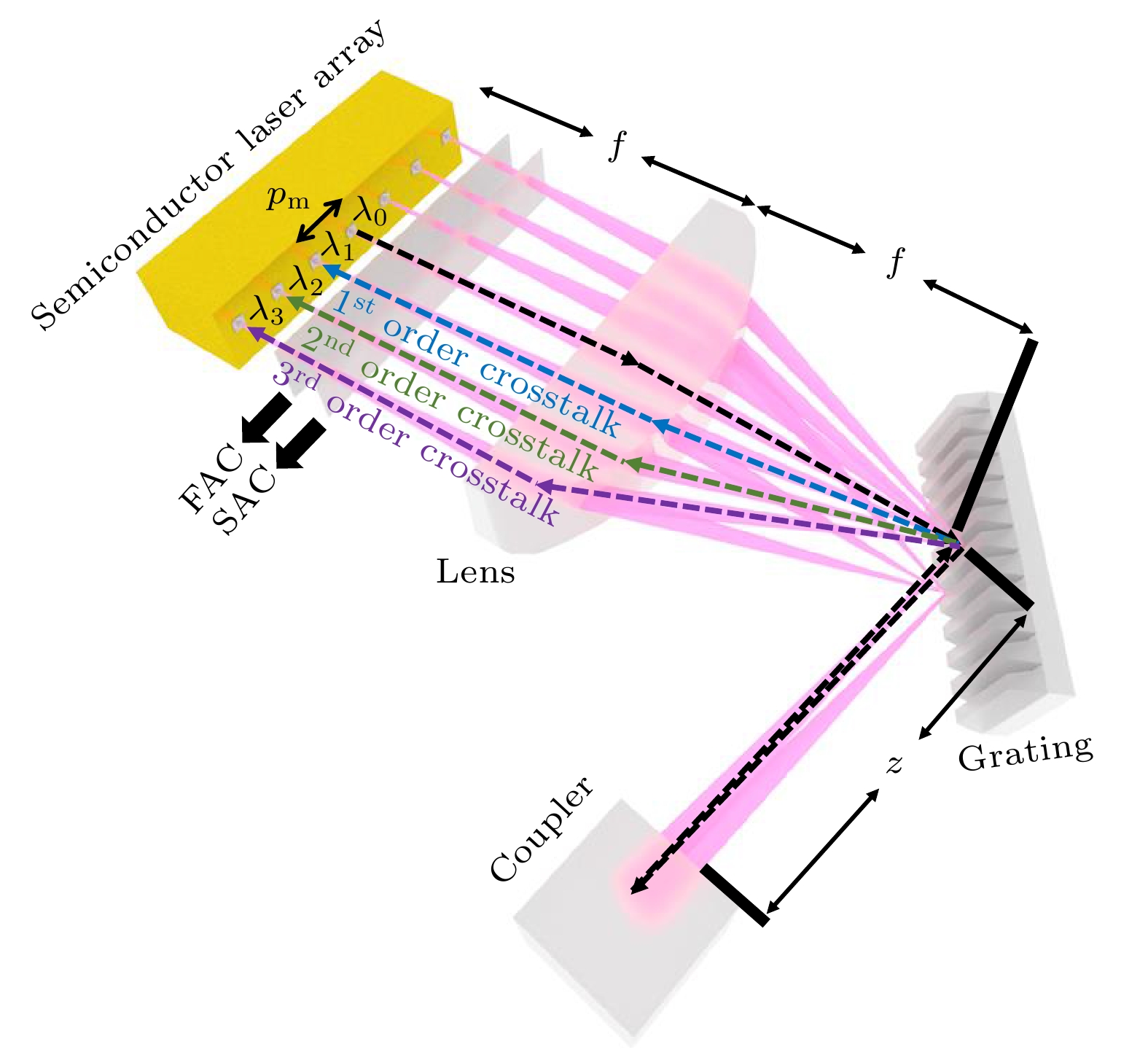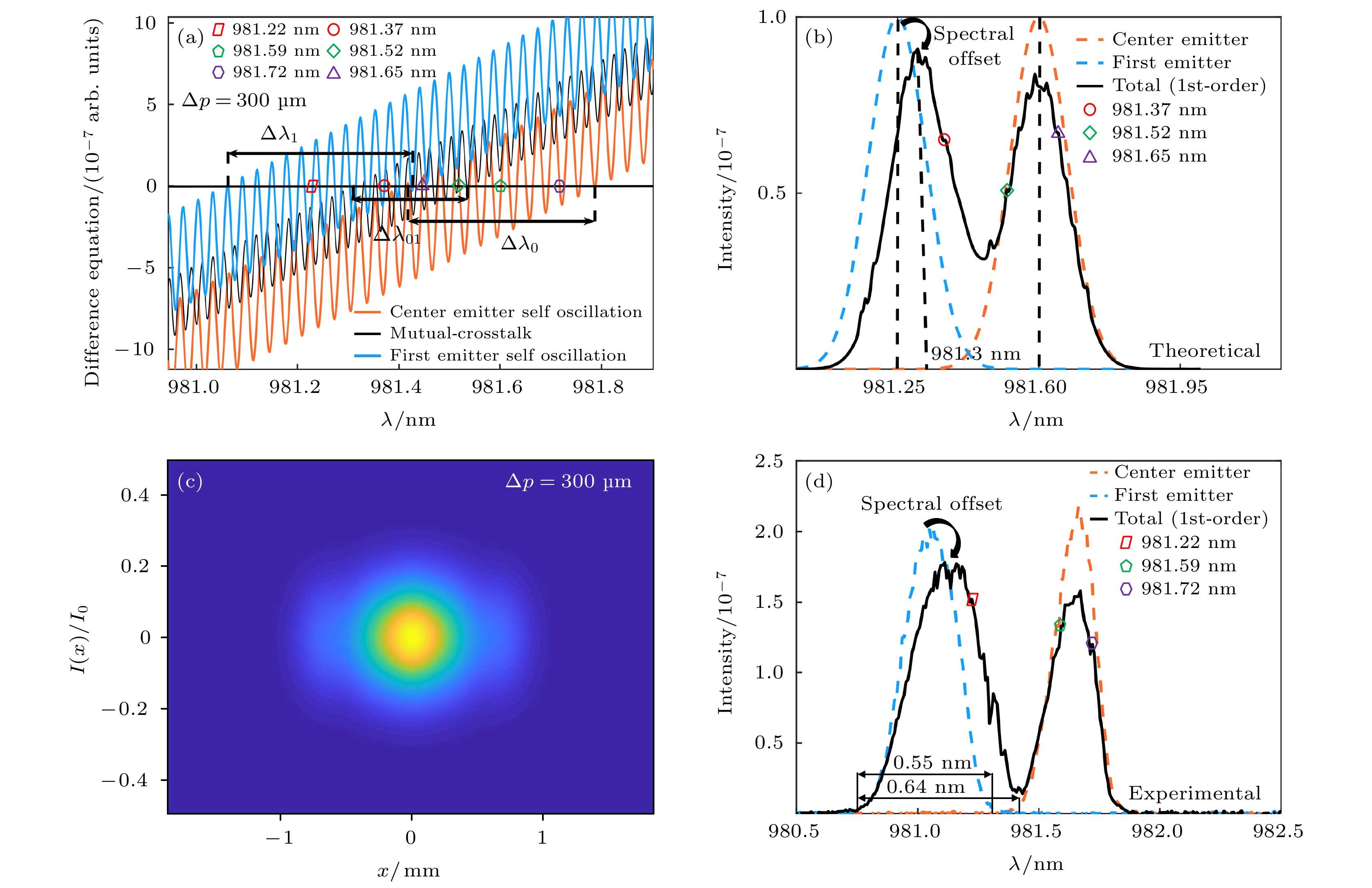-
在外腔反馈半导体激光谱合束系统中, 由于半导体激光阵列的“smile”效应、外腔中光学元件制作误差等因素, 激光阵列一子单元发射光束经过外腔返回注入其他子单元, 在两子单元之间形成光束串扰并影响合束特性. 本文从耦合腔光束谐振角度出发, 基于光反馈半导体激光器速率方程, 构建了耦合腔谐振模型, 推导了激光器稳态输出时能在耦合腔中起振的光束模式. 结合耦合腔模式竞争机制与耦合腔谐振模型分析由两子单元间距变化引起的不同串扰对锁定光谱和合束效率的影响. 结果表明子单元间的串扰行为会造成光谱峰值下降、光谱偏移、边缘毛刺以及合束效率劣化. 相比距离更远的两子单元之间的高阶串扰, 距离更近的两子单元间的低阶串扰对合束特性的劣化程度更大. 最后, 为证明该模型的正确性和有效性, 对所得分析结果进行了实验验证, 实验观测到在串扰影响下的光谱结构与理论分析一致.In spectral beam combining systems based on a grating-external cavity, due to some factors such as the “smile” effect of the semiconductor laser array and the error of the optical components in the external cavity, the beam from one emitter transmits into the external cavity and then can return to other emitters, thereby forming beam crosstalk between the two emitters. In this work, in order to investigate the physical mechanism of beam crosstalk and the influence of beam crosstalk on beam properties such as locked spectra and beam combining efficiency, based on the optical feedback semiconductor rate equation, the beam modes that can stably oscillate in the coupling cavity are derived, and the coupling cavity oscillating model is built. With the consideration of the mode competition mechanism in the coupling cavity, the effects of different crosstalk between two emitters with different intervals on the locked spectra are analyzed in detail. The results show that crosstalk leads to the shift of the peak of locked spectrum and the generation of sub-peak. The crosstalk between two closer emitters has a more serious influence on the beam spectrum structure, combined beam spot, and combining efficiency. The combining efficiencies influencing the 1st, 2nd and 3rd crosstalk are 45.5%, 50.2%, and 63.8%, respectively (When there is no crosstalk, the efficiency is 80.1%). Finally, the results of the theoretical analysis are verified experimentally, and the experimentally observed spectra under the influence of crosstalk show phenomena such as peak degradation, peak shift, edge burrs, and side lobes in spectra, which are consistent with the theoretical predictions. Moreover, according to the simulation results and experimental observations, it is found that the crosstalk can be suppressed to a certain extent by increasing the spacing between emitters, and the Galileo telescope system is suggested to suppress crosstalk and optimize the spectral structure and beam combining efficiency. Compared with the Kepler telescope structure, the Galileo telescope does not have a real focal point, which can prevent the local power from being too high, thereby damaging the optical components.
-
Keywords:
- beam crosstalk /
- diode laser array /
- rate equation /
- mode resonance
[1] Yan Y X, Zheng Y, Sun H G, Duan J A 2021 Front. Phys. 9 1
 Google Scholar
Google Scholar
[2] Verdaasdonk R M, Borst C 1991 Appl. Opt. 30 2172
 Google Scholar
Google Scholar
[3] Extance A 2015 Nature 521 408
 Google Scholar
Google Scholar
[4] Brauch U, Loosen P, Opower H 2000 Appl. Phys. 78 303
 Google Scholar
Google Scholar
[5] Sanchez-Rubio A, Fan T Y, Augst S J, Goyal A K, Creedon K J, Gopinath J T, Daneu V, Chann B, Huang R 2014 Lincoln Lab. J. 20 52
[6] Vijayakumar D, Jensen O B, Ostendorf R, Westphalen T, Thestrup B 2010 Opt. Express 18 893
 Google Scholar
Google Scholar
[7] Hecht J 2012 Laser Focus World 48 50
[8] Huang R K, Chann B, Burgess J, Lochman B, Zhou W, Cruz M, Cook R, Dugmore D, Shattuck J, Tayebati R 2015 Proc. SPIE 9730 97300C-1
 Google Scholar
Google Scholar
[9] Sevian A, Andrusyak O, Ciapurin I, Smirnov V, Venus G, Glebov L 2008 Opt. Lett. 33 384
 Google Scholar
Google Scholar
[10] Ma H J, Xiao Y, Hu C, Song Y Y, Tang X H 2021 Appl. Opt. 60 8213
 Google Scholar
Google Scholar
[11] Song Y Y, Yu X, Hu C, Wang P, Ma H J, Tang X H 2021 Appl. Opt. 61 3390
 Google Scholar
Google Scholar
[12] Wu Z, Yang L, Zhang B 2017 Appl. Opt. 56 1
 Google Scholar
Google Scholar
[13] Meng H C, Sun T Y, Tan H, Yu J H, Du W C, Tian F, Li J M, Gao S X, Wang X J, Wu D Y 2015 Opt. Express 23 21819
 Google Scholar
Google Scholar
[14] Zhu Z D, Gou L, Jiang M H, Hui Y L, Lei H, Li Q 2014 Opt. Express 22 17804
 Google Scholar
Google Scholar
[15] Lang R, Kobayashi K 1980 IEEE J. Quant. Electron. 16 347
 Google Scholar
Google Scholar
[16] Memon F A, Morichetti F, Arain Z A, Korai U A, Melloni A 2019 Wireless Pers. Commun. 106 2149
 Google Scholar
Google Scholar
[17] 王安帮 2006 硕士学位论文 (太原: 太原理工大学)
Wang A B 2006 M. S. Dissertation (Taiyuan: Taiyuan University of Science and Technology) (in Chinese)
[18] Binder J O, Cormack G D 1989 IEEE J. Quant. Electron. 25 2255
 Google Scholar
Google Scholar
[19] Tromborg B, Osmundsen J H, Olesen H 1984 IEEE J. Quant. Electron. QE-20 1023
 Google Scholar
Google Scholar
[20] Gong H, Liu Z G, Zhou Y L, Zhang W B, Lv T 2014 Appl. Opt. 53 694
 Google Scholar
Google Scholar
[21] 钟哲强, 杨 磊, 胡小川, 张 彬 2015 中国激光 42 1002010
 Google Scholar
Google Scholar
Zhong Z Q, Yang L, Hu X C, Zhang B 2015 Chin. J. Lasers 42 1002010
 Google Scholar
Google Scholar
[22] Yang L, Wu Z, Zhong Z Q, Zhang B 2017 Opt. Commun. 384 30
 Google Scholar
Google Scholar
[23] 吴肖杰 2018 硕士学位论文 (长春: 长春理工大学)
Wu X J 2018 M. S. Dissertation (Changchun: Changchun University of Science and Technology) (in Chinese)
-
-
[1] Yan Y X, Zheng Y, Sun H G, Duan J A 2021 Front. Phys. 9 1
 Google Scholar
Google Scholar
[2] Verdaasdonk R M, Borst C 1991 Appl. Opt. 30 2172
 Google Scholar
Google Scholar
[3] Extance A 2015 Nature 521 408
 Google Scholar
Google Scholar
[4] Brauch U, Loosen P, Opower H 2000 Appl. Phys. 78 303
 Google Scholar
Google Scholar
[5] Sanchez-Rubio A, Fan T Y, Augst S J, Goyal A K, Creedon K J, Gopinath J T, Daneu V, Chann B, Huang R 2014 Lincoln Lab. J. 20 52
[6] Vijayakumar D, Jensen O B, Ostendorf R, Westphalen T, Thestrup B 2010 Opt. Express 18 893
 Google Scholar
Google Scholar
[7] Hecht J 2012 Laser Focus World 48 50
[8] Huang R K, Chann B, Burgess J, Lochman B, Zhou W, Cruz M, Cook R, Dugmore D, Shattuck J, Tayebati R 2015 Proc. SPIE 9730 97300C-1
 Google Scholar
Google Scholar
[9] Sevian A, Andrusyak O, Ciapurin I, Smirnov V, Venus G, Glebov L 2008 Opt. Lett. 33 384
 Google Scholar
Google Scholar
[10] Ma H J, Xiao Y, Hu C, Song Y Y, Tang X H 2021 Appl. Opt. 60 8213
 Google Scholar
Google Scholar
[11] Song Y Y, Yu X, Hu C, Wang P, Ma H J, Tang X H 2021 Appl. Opt. 61 3390
 Google Scholar
Google Scholar
[12] Wu Z, Yang L, Zhang B 2017 Appl. Opt. 56 1
 Google Scholar
Google Scholar
[13] Meng H C, Sun T Y, Tan H, Yu J H, Du W C, Tian F, Li J M, Gao S X, Wang X J, Wu D Y 2015 Opt. Express 23 21819
 Google Scholar
Google Scholar
[14] Zhu Z D, Gou L, Jiang M H, Hui Y L, Lei H, Li Q 2014 Opt. Express 22 17804
 Google Scholar
Google Scholar
[15] Lang R, Kobayashi K 1980 IEEE J. Quant. Electron. 16 347
 Google Scholar
Google Scholar
[16] Memon F A, Morichetti F, Arain Z A, Korai U A, Melloni A 2019 Wireless Pers. Commun. 106 2149
 Google Scholar
Google Scholar
[17] 王安帮 2006 硕士学位论文 (太原: 太原理工大学)
Wang A B 2006 M. S. Dissertation (Taiyuan: Taiyuan University of Science and Technology) (in Chinese)
[18] Binder J O, Cormack G D 1989 IEEE J. Quant. Electron. 25 2255
 Google Scholar
Google Scholar
[19] Tromborg B, Osmundsen J H, Olesen H 1984 IEEE J. Quant. Electron. QE-20 1023
 Google Scholar
Google Scholar
[20] Gong H, Liu Z G, Zhou Y L, Zhang W B, Lv T 2014 Appl. Opt. 53 694
 Google Scholar
Google Scholar
[21] 钟哲强, 杨 磊, 胡小川, 张 彬 2015 中国激光 42 1002010
 Google Scholar
Google Scholar
Zhong Z Q, Yang L, Hu X C, Zhang B 2015 Chin. J. Lasers 42 1002010
 Google Scholar
Google Scholar
[22] Yang L, Wu Z, Zhong Z Q, Zhang B 2017 Opt. Commun. 384 30
 Google Scholar
Google Scholar
[23] 吴肖杰 2018 硕士学位论文 (长春: 长春理工大学)
Wu X J 2018 M. S. Dissertation (Changchun: Changchun University of Science and Technology) (in Chinese)
计量
- 文章访问数: 8638
- PDF下载量: 122
- 被引次数: 0














 下载:
下载:





